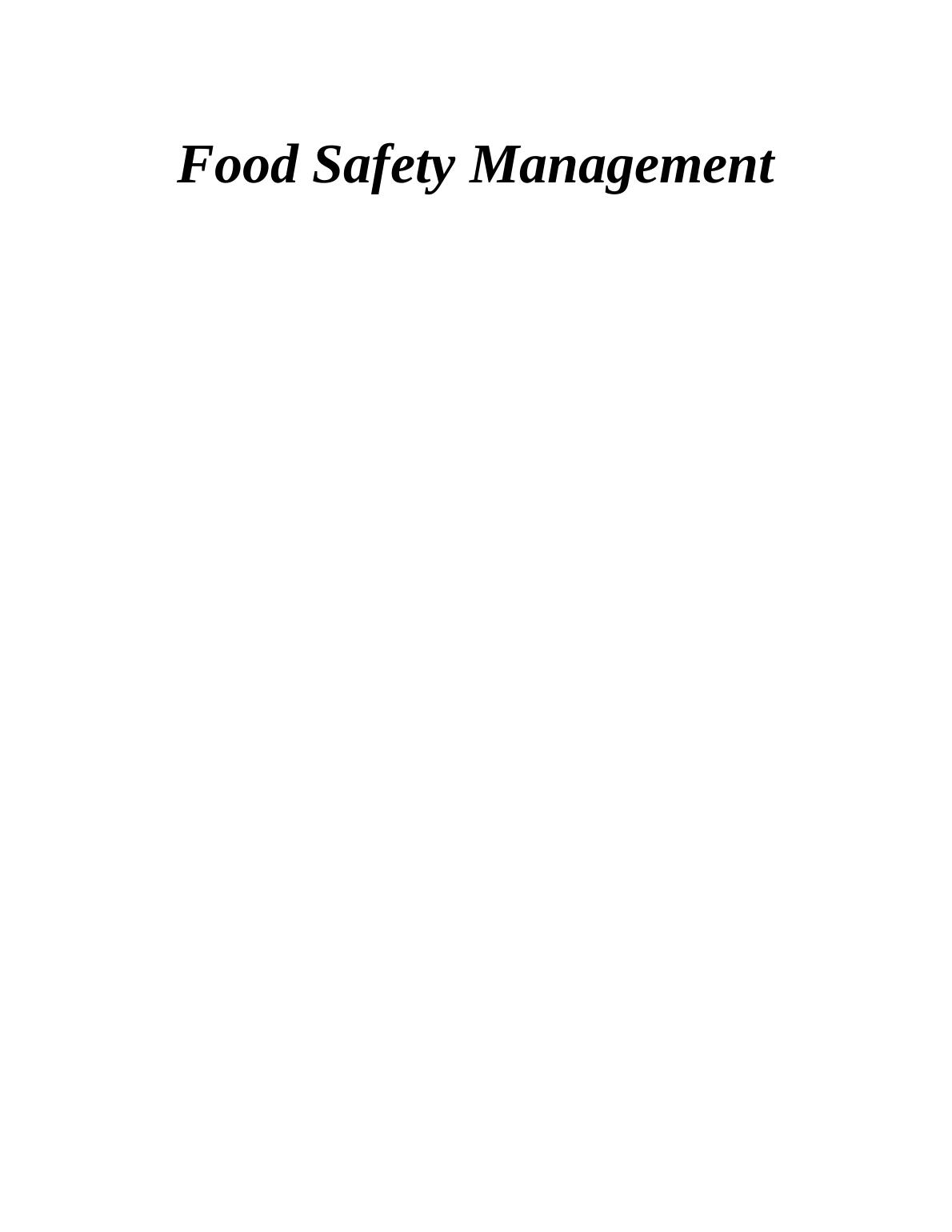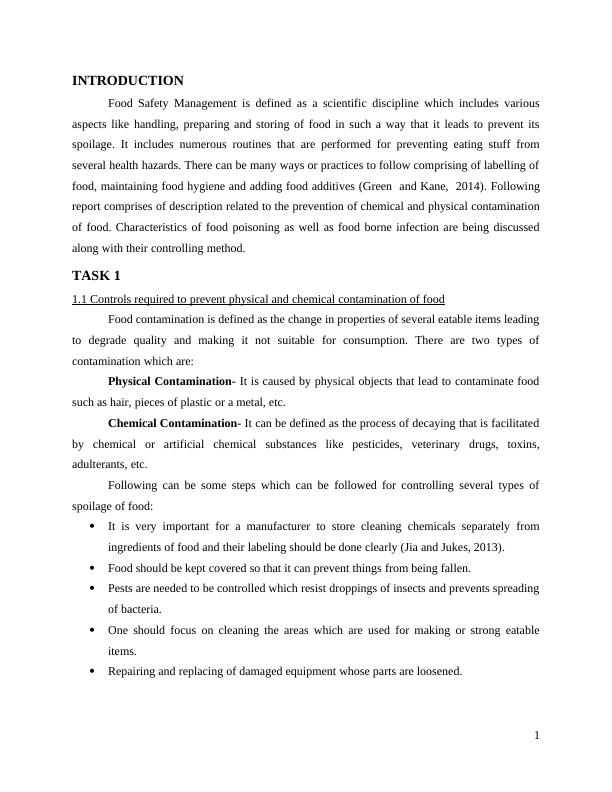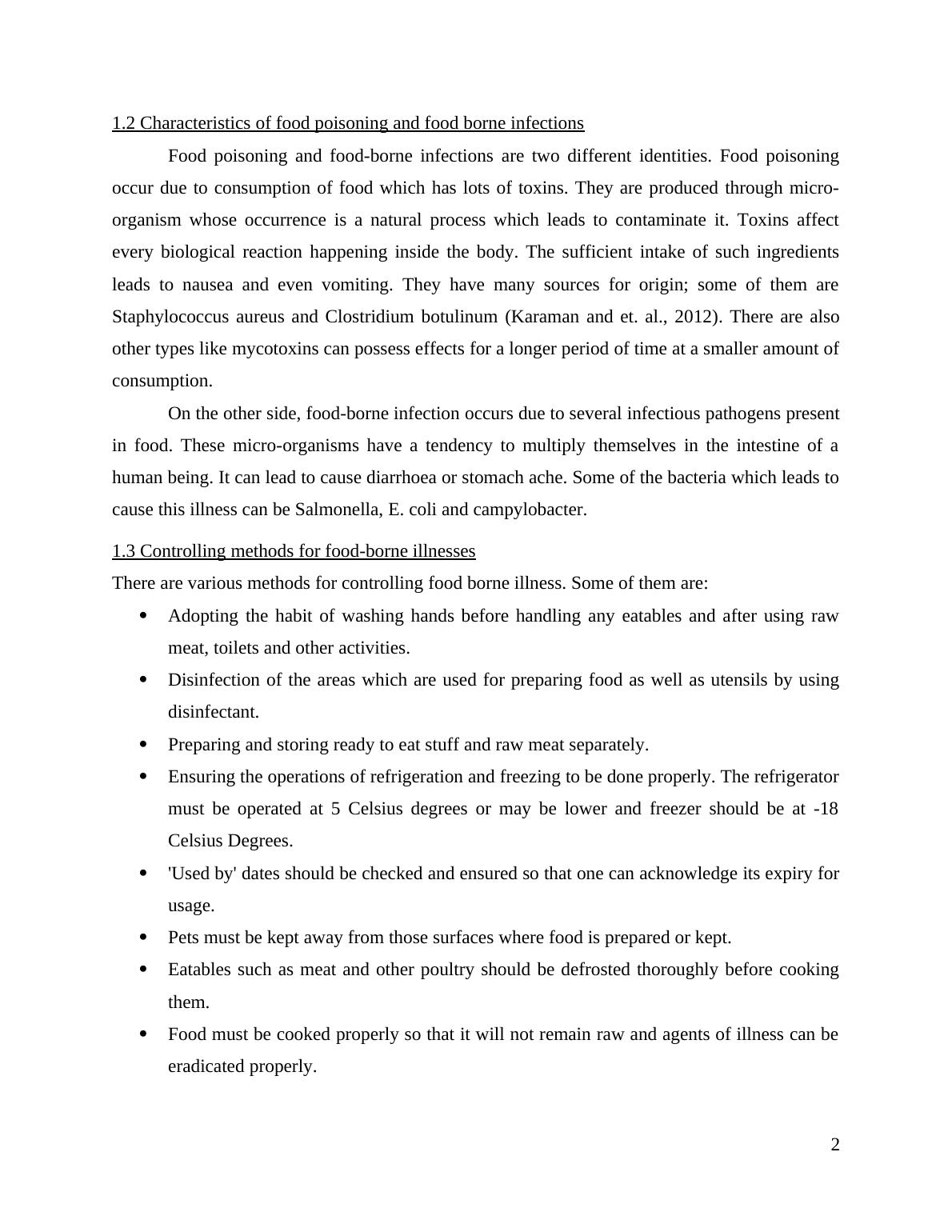Controlling food safety in a temperature contractive environment
13 Pages3450 Words389 Views
Added on 2020-12-29
About This Document
Food Safety Management INTRODUCTION 1 TASK 11 1.1 Controls required to prevent physical and chemical contamination of food 1 1.2 Characteristics of food poisoning and food borne infections 2 1.3 Controlling methods for food-borne illnesses2 TASK 23 2.1 Categorization of the food-spoilage agents 3 Food-spoilage agents3 2.2 Methods of food preservation 3 2.3 Evaluation of the effectiveness of food preservation methods 4 TASK 34 3.1 the key steps in a temperature control system.4 3.2 methods for the safe storage
Controlling food safety in a temperature contractive environment
Added on 2020-12-29
ShareRelated Documents
Food Safety Management

Table of ContentsINTRODUCTION...........................................................................................................................1TASK 1 ...........................................................................................................................................11.1 Controls required to prevent physical and chemical contamination of food........................11.2 Characteristics of food poisoning and food borne infections................................................21.3 Controlling methods for food-borne illnesses.......................................................................2TASK 2............................................................................................................................................32.1 Categorization of the food-spoilage agents ..........................................................................3Food-spoilage agents ..................................................................................................................32.2 Methods of food preservation...............................................................................................32.3 Evaluation of the effectiveness of food preservation methods.............................................4TASK 3............................................................................................................................................43.1 the key steps in a temperature control system......................................................................43.2 methods for the safe storage of food....................................................................................53.3 the importance of personal hygiene .....................................................................................53.4 Evaluation of cleaning and disinfection as a process ...........................................................63.5 problems associated with pest control .................................................................................63.6 the need for hygienic design and construction of food premises..........................................73.7 importance of training as a quality assurance mechanism...................................................74.1 food hazard risk assessment..................................................................................................74.2 food safety control system....................................................................................................84.3 food safety guide for legislation compliance.......................................................................8CONCLUSION................................................................................................................................9REFERENCES..............................................................................................................................10

INTRODUCTIONFood Safety Management is defined as a scientific discipline which includes variousaspects like handling, preparing and storing of food in such a way that it leads to prevent itsspoilage. It includes numerous routines that are performed for preventing eating stuff fromseveral health hazards. There can be many ways or practices to follow comprising of labelling offood, maintaining food hygiene and adding food additives (Green and Kane, 2014). Followingreport comprises of description related to the prevention of chemical and physical contaminationof food. Characteristics of food poisoning as well as food borne infection are being discussedalong with their controlling method.TASK 1 1.1 Controls required to prevent physical and chemical contamination of foodFood contamination is defined as the change in properties of several eatable items leadingto degrade quality and making it not suitable for consumption. There are two types ofcontamination which are:Physical Contamination- It is caused by physical objects that lead to contaminate foodsuch as hair, pieces of plastic or a metal, etc.Chemical Contamination- It can be defined as the process of decaying that is facilitatedby chemical or artificial chemical substances like pesticides, veterinary drugs, toxins,adulterants, etc.Following can be some steps which can be followed for controlling several types ofspoilage of food:It is very important for a manufacturer to store cleaning chemicals separately fromingredients of food and their labeling should be done clearly (Jia and Jukes, 2013).Food should be kept covered so that it can prevent things from being fallen.Pests are needed to be controlled which resist droppings of insects and prevents spreadingof bacteria.One should focus on cleaning the areas which are used for making or strong eatableitems.Repairing and replacing of damaged equipment whose parts are loosened.1

1.2 Characteristics of food poisoning and food borne infectionsFood poisoning and food-borne infections are two different identities. Food poisoningoccur due to consumption of food which has lots of toxins. They are produced through micro-organism whose occurrence is a natural process which leads to contaminate it. Toxins affectevery biological reaction happening inside the body. The sufficient intake of such ingredientsleads to nausea and even vomiting. They have many sources for origin; some of them areStaphylococcus aureus and Clostridium botulinum (Karaman and et. al., 2012). There are alsoother types like mycotoxins can possess effects for a longer period of time at a smaller amount ofconsumption.On the other side, food-borne infection occurs due to several infectious pathogens presentin food. These micro-organisms have a tendency to multiply themselves in the intestine of ahuman being. It can lead to cause diarrhoea or stomach ache. Some of the bacteria which leads tocause this illness can be Salmonella, E. coli and campylobacter.1.3 Controlling methods for food-borne illnessesThere are various methods for controlling food borne illness. Some of them are:Adopting the habit of washing hands before handling any eatables and after using rawmeat, toilets and other activities.Disinfection of the areas which are used for preparing food as well as utensils by usingdisinfectant.Preparing and storing ready to eat stuff and raw meat separately.Ensuring the operations of refrigeration and freezing to be done properly. The refrigeratormust be operated at 5 Celsius degrees or may be lower and freezer should be at -18Celsius Degrees.'Used by' dates should be checked and ensured so that one can acknowledge its expiry forusage.Pets must be kept away from those surfaces where food is prepared or kept.Eatables such as meat and other poultry should be defrosted thoroughly before cookingthem.Food must be cooked properly so that it will not remain raw and agents of illness can beeradicated properly.2

End of preview
Want to access all the pages? Upload your documents or become a member.
Related Documents
Food Safety Management - Assignmentlg...
|13
|3257
|64
Food Safety Management PDFlg...
|11
|3417
|79
Food Safety Management- Doclg...
|11
|3084
|211
Table of Contents Introduction to Food Safety Managementlg...
|12
|3340
|412
Food Safety Management Assignment Samplelg...
|15
|2956
|25
Food Safety Management Assignment Solution - Doclg...
|15
|3565
|451
